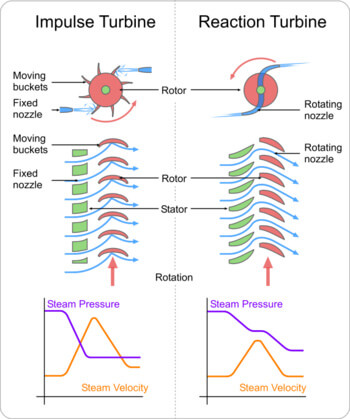Steam Turbines
In turbines and jet engines, thermal energy conversion into mechanical energy is accomplished with participation of external kinetic energy of the gas jet. In turbines, kinetic energy of gas or steam jet causes torque of the wheel, in jet engines - reaction force at the nozzle outlet. A nozzle is a channel in which, as gas passes through, the gas expands with increase in the rate of passage and a decrease in pressure converting potential energy of the working medium into kinetic energy.
The process of transition of potential energy of gas into kinetic energy as it moves through a nozzle can be explained using the first law of thermodynamics.
Let's denote the pressure, specific volume, specific internal energy and gas velocity at the nozzle inlet with the cross-sectional area
To obtain supersonic speeds, turbines are equipped with combined nozzles consisting of narrowing and then expanding parts (Laval nozzle) where gas continues to expand in the expanding part so that its flow rate exceeds the critical value.
Steam turbine design and operation principle
The steam turbine is a type of a vane engine. Its operating device is a disc with a crown of curved working blades mounted on the shaft. In front of blades is a series of simple or combined nozzles. Nozzles are fixed part of the turbine; they are attached to the housing or the diaphragm.

The set of rotating parts of the turbine is the shaft, the disks with working blades is its rotor, and the stationary parts are the stator. The turbine stator consists of a foundation frame, a split steel or cast-iron housing, labyrinth seals at the points of shaft passage through the housing, diaphragms with a nozzle array dividing the space inside the housing into separate chambers - pressure stages.
The operation principle of a turbine is explained by two processes occurring in the nozzle arrays and channels formed by working blades as the working medium - steam or gas - passes through them.
In nozzles the potential energy of steam is converted into kinetic energy; centrifugal force in the blade channel is generated by the steam jet acting on blades and causes rotation of the turbine rotor. When the shaft is connected to the current generator, mechanical energy is converted into electrical energy.
The single-disc turbine does not make enough use of kinetic energy of the steam jet. Its considerable part is lost with the exit velocity of steam leaving the turbine which reduces efficiency of the turbine. In addition the excessively high rotation rates are not required for current generators. In order to reduce angular velocity and increase turbine efficiency, they are made multistage - with speed and pressure stages.
Depending on the operation principles, turbines are divided into active and reaction depending on the nature of the forces that cause the shaft to rotate. A feature of reaction turbines is the asymmetrical shape of the blades forming curvilinear tapered channels. Steam as it moves through such channels continues to expand at the nozzle exit increasing its relative velocity. In addition to centrifugal force this causes reaction pressure force acting on blades.
Turbines operating per the active principles have symmetrical blade forms and the vane channel of almost uniform cross section. Therefore, the pressure drop and steam velocity increase in them occur only in nozzles, working blades use only kinetic energy of steam.
The turbine has two parallel blade tips on a single disc. Between them are fixed guide vanes for smooth transition of the steam jet from one tip to the other in order to maintain the same direction of force acting on the blade of each row. Pressure from р0 to р\ drops in nozzles only and on working blade it remains constant. As pressure in the nozzles drops, kinetic energy increases which is equally distributed between two rows of blades turning into work on the turbine shaft. Velocity change on guide vanes is very small due to some frictional loss. Turbines have low efficiency and low power; they are used to drive small machines (centrifugal pumps, etc.).
Types and applications of steam turbines
Steam turbines are mostly used in fixed installations at thermal power plants for driving current generators, less often in small industrial plants for driving fans and pumps.
According to the nature of the thermal process turbines are subdivided into condensing turbines with all steam thrown into the condenser and heating turbines (condensing turbines with controlled steam extraction and turbines with backpressure) in which some or all steam is extracted from intermediate pressure stages for production needs, heating and hot water supply. The overall coefficient of fuel heat utilization when using cogeneration turbines (at CHPPs) reaches 80% or more.
According to parameters of fresh steam there are medium pressure turbines of 3.43 MPa and 708 K (435 ° C) temperature, increased pressure 8.8 MPa and 808 K (535 ° C) temperature, high pressure 12.75 MPa and 838 K (565 ° C) temperature and supercritical parameters: pressure 23.55 MPa and temperature of 838 K (565 ° C).
According to the number of housings (cylinders) turbines can be single-cylinder, double-cylinder and multi-cylinder.
According to the number of stages they are single-stage (low-power) and multistage active and reaction types of low, medium and high power up to 800 MW at supercritical steam parameters.
Steam turbines have advantages over other engines. They make it possible to obtain high power and high efficiency in one unit, to use any type of fuel to produce steam, to use energy spent in them to produce steam or hot water; they are relatively small in size and reliable in operation.
